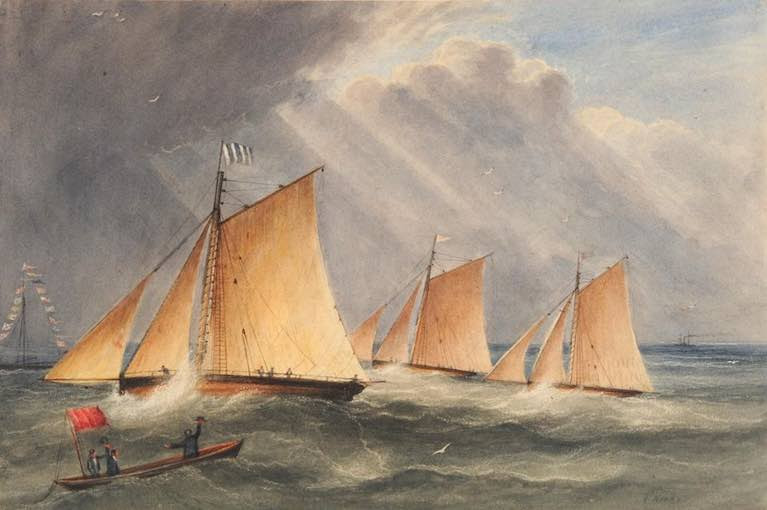The history of sailing in Belfast Lough became so hectic in the 1890s, with the pioneering development of One-design keelboat classes and the first of Thomas Lipton's five America's Cup challenges going forth from Royal Ulster Yacht Club in 1899, that the achievements of previous eras became eclipsed. Thus the busy local sailors - if they'd time to think of their sport's local history at all - tended to think that its proper organisation had begun as recently as 1866, when the Ulster YC was founded in Belfast - becoming the RUYC at Bangor by 1869 - while the Carrickfergus Amateur Rowing Club also came into being at that ancient harbour with its impressive Norman castle on the north shore of the lough.
 The pioneering Belfast Lough Number One Class of 1897, designed by William Fife and built by John Hilditch of Carrickfergus. So much was being freshly developed in sailing on the lough in the 1890s that the first recreational sailing steps of a century earlier tended to be overlooked.
The pioneering Belfast Lough Number One Class of 1897, designed by William Fife and built by John Hilditch of Carrickfergus. So much was being freshly developed in sailing on the lough in the 1890s that the first recreational sailing steps of a century earlier tended to be overlooked.
From the beginning, the rowing club included sailing enthusiasts, and nowadays it is purely and simply the marina-side Carrickfergus Sailing Club. But whatever its origins, in 2016 both it and the RUYC celebrated their Sesquicentennials and seniority with such exuberance that few noticed the tiny squeak of protest from Holywood on the County Down coast (it's Rory McIlroy's home town), to the effect that Holywood Yacht Club (a notably hospitable place, despite its drying moorings) could definitely claim a continuous existence back to 1862, and it was generally accepted that it was actually older than that.
As it happens, in the following Spring, Holywood YC found itself hosting a semi-impromptu performance by Van Morrison which – for any sailing club however distinguished or otherwise – must have made any debates about precise seniority seem largely irrelevant. But the fascinating story of Belfast Lough's early sailing has come alive again through a sight of our header painting, which is in the collection of the Ulster Museum.
We now know about it thanks to Mark Doherty of Belfast, who is involved on many fronts in the city's maritime history. As well, at a personal level, he is fascinated by the Chichester family from Devon who took over much of the north after the Flight of the Earls in 1607. He maintains this almost benign interest despite the fact that his distant Doherty ancestors were usurped in their ancestral lands in Inishowen in Donegal through the chiefs of the Chichester family going about the business of gradually elevating themselves to become the Marquess of Donegall.
In time, everything changes. The leading Chichesters were always over-stretching their ambitions, such that in the 1840s the City of Belfast was sold from under them to pay off their debts. And the current Marquess now lives very quietly in the depths of rural Wexford, which is about as far as you can get from Donegal within Ireland without falling into the sea.
As for the city which they formerly dominated, it was a native Donegal man, developer Pat Doherty of Harcourt Holdings in Dublin, who in recent years had the crazy idea of developing the city's former shipbuilding and dockland area as a tourist attraction to be known as the Titanic Quarter. Crazy idea indeed…..what goes round comes round.
 Belfast today. Its original charter was granted to Sir Arthur Chichester in 1613, but in the 1840s the city was sold from under his descendants in order to pay some of their unsustainable debts.
Belfast today. Its original charter was granted to Sir Arthur Chichester in 1613, but in the 1840s the city was sold from under his descendants in order to pay some of their unsustainable debts.
But though the Chichesters may have ploughed their way through several fortunes over the centuries, there were times when they spent well and with vision, and one such was in the 1830s, when the son and heir, the Earl of Belfast, commissioned the building of the speedy brig yacht Waterwitch, whose story we featured here
At the time, we assumed the Chichesters took themselves off to the Solent to do most of their yachting, as did a later Belfast magnate, linen manufacturer John Mulholland with his famous schooner Egeria. But the painting of 1829 reveals that third place is being taken by Zoe, owned by the Marquess of Donegall, father of the Earl of Belfast of Waterwitch fame.
So not only was an annual Belfast Regatta an established event in 1829, but it links us to other parts of Belfast history, as the winning boat Ariel is listed in some accounts as owned by John McCracken, and in others as Francis McCracken. Either way, this is the yacht of the McCracken family, and both John and Francis were brothers of Henry Joy McCracken, executed in Belfast in 1798 for his role in the Rising of the United Irishmen, but known to a few as having been a pioneering sailing man who left behind some lively writings of his experiences afloat in Belfast Lough and in cruising to the Scottish Hebrides.
 Henry Joy McCracken in serious mood - his sailing writings were said to reveal a light-hearted side
Henry Joy McCracken in serious mood - his sailing writings were said to reveal a light-hearted side
After the turmoil of 1798, Belfast was kept tightly under control and those who had industrial projects with potential were given every encouragement to expand. But although the business of Belfast very rapidly became business and large-scale manufacture, even though their lough and the air of their city was becoming increasingly polluted, as peace prevailed the sailing revived.
Such was the strength of local sailing that in the Autumn of 1824, the Northern Yacht Club was formed in Belfast with many of Henry Joy McCracken's former colleagues, friends and relatives in its membership. But as was increasingly the case, there were several Glasgow businessmen in town at the time, the sailing ones attended the meeting, and back in Scotland they formed a Scottish branch of the new Northern Yacht Club in the summer of 1825.
Conditions in the Firth of Clyde were so much better suited to recreational sailing than the Belfast Lough of the 19th Century that the Scottish branch took off, it became the Royal Northern Yacht Club by 1834, and in 1838 the founding Belfast branch found its activities so depleted by the readily available attractions of Clyde sailing that it was wound up and its dwindling funds – something like thirteen guineas – were transferred to the RNYC.
 The Royal Northern Yacht Club regatta in the Clyde in 1835 indicated how strongly the Scottish branch was setting the pace in the club
The Royal Northern Yacht Club regatta in the Clyde in 1835 indicated how strongly the Scottish branch was setting the pace in the club
Nevertheless, annual Belfast Regattas continued – we can find reference to one in 1850 – though if it was to be an event of style, it relied on yachts coming from the Clyde and Dublin Bay to make up the numbers. Nevertheless, the way that Holywood Yacht Club emerged in 1862 indicated there'd long been a local tradition of sailing from the coast between Holywood and Cultra.
But now with this painting from 1829, we have a very tangible record of those "lost years" before the 1860s. It's by the Belfast painter Andrew Nicholl (1804-1886) who was still in the early stages of a notable career, and it's highly likely that he was encouraged to record the regatta by Francis McCracken, who was already an enthusiastic art collector.
Bits of it are very good, other parts are less accomplished, but it certainly conveys the sense of excitement of a close finish on a breezy day, while modern sailors will be intrigued to notice that the winning McCracken yacht Ariel is fitted with guard-rails – the RORC didn't make them compulsory until 1963.
 Close finish. The guard-rails right round the McCracken family's winning Ariel were an idea ahead of its time.
Close finish. The guard-rails right round the McCracken family's winning Ariel were an idea ahead of its time.
As for the boat which is second, the Crusader, her owner Sir Frederick May has his family name remembered in May's Market and other places in Belfast, while Mark Doherty fills us in on some background to the effect that the May and Donegall families were at one stage united through marriage the better the facilitate schemes to accumulate quick money, sometimes managing to avoid debt for over forty years. But equally, there were other family members of an heroically philanthropic disposition.
Andrew Nicholl was showing such promise that he was enticed to Dublin, and the development of his style is revealed in the watercolours he did of the new Dublin & Kingstown Railway soon after it had its opening in 1834.
 Andrew Nicholl's portrayal of the new Dublin and Kingstown Railway at Blackrock
Andrew Nicholl's portrayal of the new Dublin and Kingstown Railway at Blackrock
Meanwhile back in Belfast, the annual regatta had continued to maintain its reputation, such that in 1830 the renowned owner-skipper Caulfield Beamish of Cork turned up to compete with his already-famous cutter Paddy, which he'd designed himself to be built by Aherne of Passage West. In an even fresher breeze than the regatta of 1829, the Paddy won in a style which rather reminds us of the way in which, in more modern times, the O'Leary family of Cork regularly went all the way to Tarbert in the Clyde to pile up the trophies with their Corby 36 Antix. Plus ca change.
 A good day for the sail repair business – Caulfield Beamish's Paddy from Cork winning the Belfast Regatta of 1830
A good day for the sail repair business – Caulfield Beamish's Paddy from Cork winning the Belfast Regatta of 1830































































